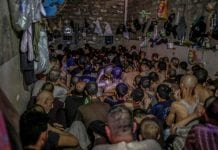
Memorial services held online. Zen meditation apps. Buddhist temple-led matchmaking services.
As the coronavirus pandemic forces institutions around the world to change the way they do things, those new endeavors are some of the ways that Buddhist groups in Japan are trying to survive.
Their temples are part of the landscape: there are about 77,000, more than the number of Japan’s ubiquitous convenience stores.
Covid-19 has caused further pain for Buddhist organizations already struggling in recent years due to Japan’s shrinking population and sagging interest in religion among the young.
One estimate is that temples’ total income has halved in the five years to 2020. And now the virus has kept believers at home, reducing donations they make for services such as memorials for the deceased.
Buddhist temples have thrived in Japan for more than a millennium. But they need money to operate, and the pandemic has prompted some priests and monks to think of new ways to generate income.
It’s a reflection of the way that industries worldwide from travel to dining and retail are having to improvise as covid-19 restrictions batter their usual business.
Ryosokuin, a Zen temple with more than 660 years of history in Kyoto, is one such innovator.
Faced with a drop-off in services such as memorials and a plunge in tourism, the organization boosted its online operations.
It developed a meditation app that’s been downloaded more than 15,000 times that it expects to eventually monetize, and it’s organized an online Zen meditation community called UnXe, meaning “cloud-sitting.”
“When we lost visitors and donations fell, we realized that our conventional way of supporting our operations no longer works,” said Toryo Ito, deputy chief priest at the temple.
“We need to adapt to a management style which meets with the times.”
Buddhism has a history stretching back to the sixth century in Japan, but few periods have brought such challenges.
Over a third of temples may disappear by 2040 as the population ages, according to Kenji Ishii, a religious studies professor at Kokugakuin University in Tokyo.
Temple income is falling, too. The total figure likely dropped about 51% since 2015 to $2.4 billion (263 billion yen) in 2020, according to estimates by Hidenori Ukai, the chief priest at the Shokakuji temple in Kyoto and a freelance journalist.




































